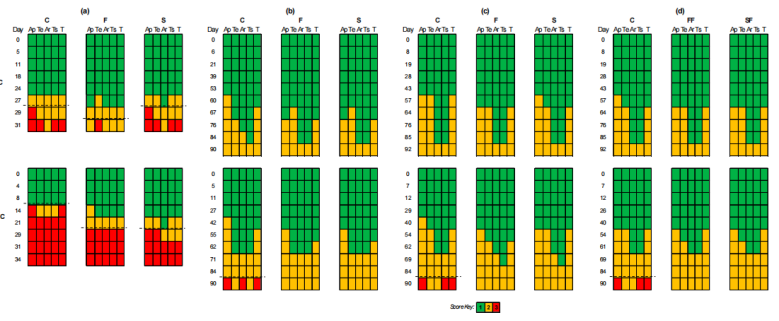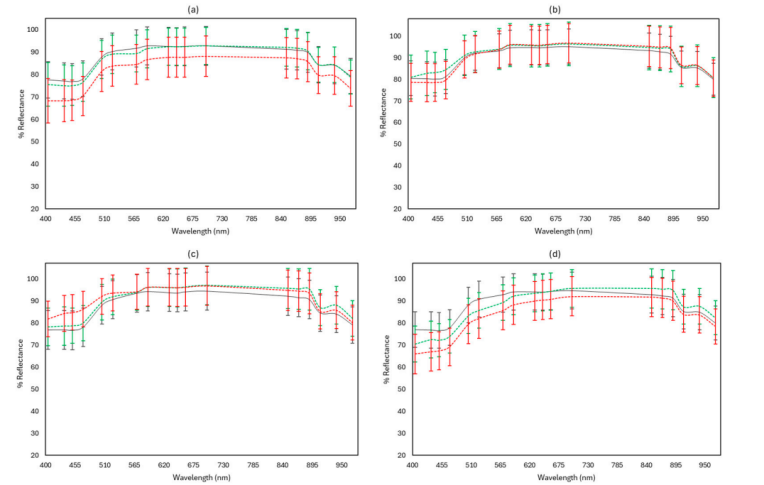品质至上,客户至上,您的满意就是我们的目标
当前位置: 首页 > 新闻动态
科学家利用Videometer多光谱成像系统发表奶酪质量研究文章
发表时间: 点击:412
来源:北京博普特科技有限公司
分享:
刚刚,科学家利用VideometerLite 便携式多光谱成像系统发表了题为“Effect of the Bioprotective Properties of Lactic Acid Bacteria Strains on Quality and Safety of Feta Cheese Stored under Different Conditions”的文章,文章发表于期刊microorganism(IF 4.1)。
乳酸菌菌株的生物保护特性对不同条件下储存的奶酪质量和安全性的影响
摘要:最近,在奶酪中加入额外的乳酸菌(LAB)菌株越来越受欢迎,因为它们会影响奶酪的营养、技术和感官特性,并提高产品的安全性。这项工作研究了戊糖乳杆菌L33和植物乳杆菌L125游离细胞和上清液对羊奶酪质量和单核细胞增生李斯特菌的影响。此外,使用傅里叶变换红外光谱(FTIR)和多光谱成像(MSI)分析等快速非侵入性技术,根据奶酪样品的感官属性对其进行分类。将羊奶酪片用3 log CFU/g的单核细胞增生李斯特菌污染,然后用(i)共培养的两种乳酸菌(LAB)的游离细胞(F,~5 log CFU/g)喷洒奶酪片,ii)LAB共培养物(S)和对照(C,UHT乳)的上清液,或用含有LAB菌株的颗粒(细胞,FF)或上清液(SF)的藻酸钠可食用膜包裹。随后,将样品储存在空气、盐水或4℃和10℃的真空中。在储存过程中,在进行感官评估的同时,监测微生物计数、pH值和水分活度(aw)。此外,在每个采样点,通过FTIR和MSI技术获取光谱数据。结果显示,奶酪的初始微生物种群约为7.6 log CFU/g,由LAB(>7 log CFU/g)和较低水平的酵母霉菌组成,未检测到肠杆菌科。在两种温度下的有氧、盐水和真空储存过程中,S和F样本的病原体种群略有推迟,与C样本相比达到了较低的水平。在盐水和真空包装中,酵母霉菌种群略有延迟。对于4℃的有氧储存,保质期延长与C和S样品相比,F样品的保质期延长了4天。在10℃下,与C样品相比,F和S样品的保质期延长了13天。FTIR和MSI分析使用PLS-DA方法提供了对奶酪质量的可靠估计,总准确率(%)分别为65.26至84.31和60.43至89.12。总之,应用生物保护性LAB菌株可以延长奶酪的保质期,并对单核细胞增生李斯特菌和腐败微生物群提供温和的抗菌作用。此外,本研究的结果验证了FTIR和MSI技术与数据分析相结合,用于快速评估胎儿样品质量的有效性。


关键词:白咸奶酪;好氧包装;可食用薄膜;单核细胞增生李斯特菌;傅里叶变换红外光谱;多光谱成像(MSI)分析
Effect of the Bioprotective Properties of Lactic Acid Bacteria Strains on Quality and Safety of Feta Cheese Stored under Different Conditions
Abstract: Lately, the inclusion of additional lactic acid bacteria (LAB) strains to cheeses is becoming more popular since they can affect cheese’s nutritional, technological, and sensory properties, as well as increase the product’s safety. This work studied the effect of Lactiplantibacillus pentosus L33 and Lactiplantibacillus plantarum L125 free cells and supernatants on feta cheese quality and Listeria monocytogenes fate. In addition, rapid and non-invasive techniques such as Fourier transform infrared (FTIR) and multispectral imaging (MSI) analysis were used to classify the cheese samples based on their sensory attributes. Slices of feta cheese were contaminated with 3 log CFU/g of L. monocytogenes, and then the cheese slices were sprayed with (i) free cells of the two strains of the lactic acid bacteria (LAB) in co-culture (F, ~5 log CFU/g), (ii) supernatant of the LAB co-culture (S) and control (C, UHT milk) or wrapped with Na-alginate edible films containing the pellet (cells, FF) or the supernatant (SF) of the LAB strains. Subsequently, samples were stored in air, in brine, or in vacuum at 4 and 10 ◦C. During storage, microbiological counts, pH, and water activity (aw) were monitored while sensory assessment was conducted. Also, in every sampling point, spectral data were acquired by means of FTIR and MSI techniques. Results showed that the initial microbial population of Feta was ca. 7.6 log CFU/g and consisted of LAB (>7 log CFU/g) and yeast molds in lower levels, while no Enterobacteriaceae were detected. During aerobic, brine, and vacuum storage for both temperatures, pathogen population was slightly postponed for S and F samples and reached lower levels compared to the C ones. The yeast mold population was slightly delayed in brine and vacuum packaging. For aerobic storage at 4 ◦C, an elongation in the shelf life of F samples by 4 days was observed compared to C and S samples. At 10 ◦C, the shelf life of both F and S samples was extended by 13 days compared to C samples. FTIR and MSI analyses provided reliable estimations of feta quality using the PLS-DA method, with total accuracy (%) ranging from 65.26 to 84.31 and 60.43 to 89.12, respectively. In conclusion, the application of bioprotective LAB strains can result in the extension of feta’s shelf life and provide a mild antimicrobial action against L. monocytogenes and spoilage microbiota. Furthermore, the findings of this study validate the effectiveness of FTIR and MSI techniques, in tandem with data analytics, for the rapid assessment of the quality of feta samples.
Keywords: white brined cheese; aerobic packaging; edible films; Listeria monocytogenes; Fourier transform infrared (FTIR) spectroscopy; multispectral imaging (MSI) analysis